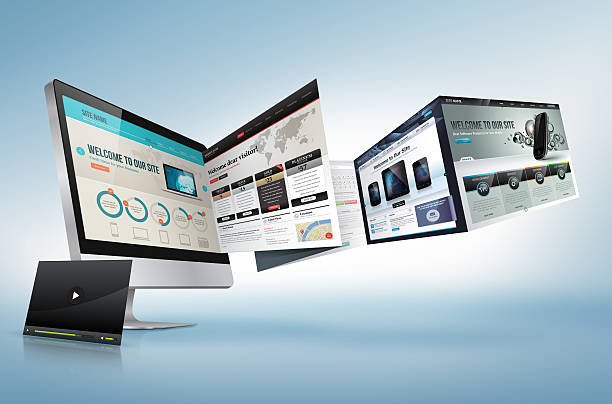Introduction to Responsive Website Design: An Urgent Need in the Digital Age

In today’s world, where various devices, including smartphones, tablets, laptops, and even smart TVs, are used to access the internet, the importance of #Responsive_Website_Design# is more evident than ever.
This design approach ensures that your website provides the best possible visual and user experience, regardless of screen size or user device type.
The era of fixed and static designs is over; now, websites must intelligently adapt to various environments.
The main goal of responsive website design is to dynamically adjust the website’s content and layout so that users on any platform can benefit from a consistent and optimized experience.
This is not just a luxury feature but a vital necessity for any business aiming to succeed in the online space.
This concept goes beyond merely displaying a website on mobile and means providing an exceptional user experience for everyone.
This approach not only increases ease of access but also significantly helps improve the site’s ranking in search engines because Google and other search engines prioritize responsive websites.
Frustrated with your e-commerce website’s low conversion rate? RasawWeb transforms your online store into a powerful tool for attracting and converting customers!
✅ Significant increase in visitor-to-buyer conversion rates
✅ Exceptional user experience to boost customer satisfaction and loyalty⚡ Get a free consultation from RasawWeb!
Fundamental Principles of Responsive Websites in Practice

Responsive website design is based on three key principles that allow a website to display smoothly and efficiently across various devices: Fluid Grids, Flexible Images, and Media Queries.
Fluid Grids use percentages for column widths and layout elements instead of fixed pixel units.
This causes the website layout to automatically adjust with the screen size, expanding or shrinking rather than remaining static.
Flexible Images, using the property max-width: 100% in CSS, ensure that images never exceed their container’s width and scale down or up proportionally to the available space.
This feature prevents unwanted horizontal scrollbars.
However, the most important component is Media Queries.
This CSS3 capability allows developers to apply different styles based on device characteristics such as screen width, height, orientation (portrait or landscape), and even resolution.
For example, you can define that on screens narrower than 768 pixels, the navigation menu changes to a hamburger icon or font sizes become smaller.
This intelligent combination of techniques provides an unparalleled user experience across diverse devices and forms the foundation of adaptable website design.
Understanding these principles is crucial for any developer looking to create a modern and user-friendly website.
Undeniable Advantages of Responsive Design for Businesses

Implementing responsive website design brings significant advantages for businesses that go beyond merely “having a mobile site.”
One of the most important benefits is improved user experience (UX).
Today’s users expect websites to function well on any device.
A properly responsive site loads faster, provides easier navigation, and displays content without the need for annoying zooming or horizontal scrolling.
This positive experience leads to increased customer satisfaction and, consequently, higher conversion rates.
The second major advantage is search engine optimization (SEO).
Google has stated for years that mobile-friendliness is an important ranking factor.
Responsive websites are preferred by search engines due to having a single URL and no need for duplicate content, which helps improve your site’s ranking in search results.
This is a unified approach to crawling and indexing that simplifies the work of search engines.
The third advantage is cost savings and easier maintenance.
Instead of developing and maintaining two or more separate versions of a website (one for desktop, one for mobile), with responsive design, there is only one codebase that minimizes the need for updates and bug fixes.
This means reduced initial development and long-term maintenance costs.
Also, with a single website, user data analysis becomes much simpler, as all traffic originates from a unified source.
These benefits generally contribute to increased efficiency and profitability.
Comparison of Responsive Design with Separate Sites
| Feature | Responsive Website Design | Separate Mobile Site (m.site.com) |
|---|---|---|
| Number of Codebases | Single Codebase | Two or more |
| Development and Maintenance Cost | Lower | Higher |
| SEO Management | Simpler (Single URL) | More complex (Duplicate content issues, redirects) |
| User Experience | Consistent and unified across all devices | May vary, requires redirects |
| Content Management | Centralized and easy | More complex, requires synchronization |
| Device Coverage | Extensive, adaptable to unknown dimensions | Limited to specific devices |
Essential Tools and Technologies for Building Responsive Websites

For the successful implementation of responsive website design, developers require a set of modern tools and technologies.
The core of this approach is based on HTML5 and CSS3.
HTML5, by providing new semantic elements (such as <header>, <nav>, <article>, <section>, <footer>), helps in better content structuring, which is crucial for responsive design and accessibility.
CSS3, however, is the main champion in layout flexibility; features like Media Queries, Flexbox, and CSS Grid allow web pages to dynamically adapt to different screen dimensions.
Furthermore, CSS frameworks like Bootstrap and Tailwind CSS significantly simplify the responsive design process.
Bootstrap, by providing ready-made components and a grid system, enables rapid creation of adaptable websites.
Tailwind CSS, with its Utility-First approach, allows for the creation of custom and responsive layouts at high speed and without the need to write CSS from scratch.
JavaScript also plays a crucial role in adding interactions and improving the user experience in responsive websites, especially for managing touch events, lazy loading images, and implementing complex mobile navigation menus.
Using tools like CSS preprocessors (such as Sass and Less) can also help organize and scale CSS codes in large projects.
Choosing the right tools is key to building an efficient and maintainable responsive website.
Are you tired of losing business opportunities due to not having a professional corporate website?
RasawWeb helps you with professional corporate website design to:
✅ Build a powerful and reliable brand image
✅ Convert website visitors into loyal customers
⚡ Get a free consultation right now!
Mobile-First Design Considerations for Responsive Websites

In the responsive website design approach, one of the most important philosophies is “Mobile-First.”
This means that the design and development process should start first for the smallest screens (like mobile) and then gradually scale up to larger screens (tablet and desktop).
This method ensures that the user experience on mobile devices is the best possible, as the focus is initially on core content and functionality, and then more complex details and elements are added for larger screens.
In mobile-first design, content prioritization is of particular importance.
It is necessary to determine which information and features are most vital for mobile users and should be accessible at first glance.
Also, interactive elements such as buttons and links should be designed to be easily tappable with a finger (a minimum of 48×48 pixels is recommended) and have sufficient space between them to prevent accidental touches.
Navigation should also be simple and accessible, typically using hamburger menus or bottom tabs.
Other considerations such as optimizing typography for readability across different screen sizes, using optimized images for faster loading, and paying attention to overall site performance (loading speed) on slow mobile networks are also very important.
This comprehensive approach ensures that the website not only displays across various dimensions but also provides a distinct and efficient user experience at every size.
Testing and Optimizing Responsive Website Performance

After completing the responsive website design, the testing and optimization phase is of paramount importance to ensure the correct and optimal performance of the site across all devices.
This stage involves a thorough review of the layout, functionality, and user experience across various screen dimensions.
One of the main testing methods is using browser developer tools (such as Chrome DevTools or Firefox Developer Tools).
These tools provide the ability to simulate various devices and change screen dimensions, allowing you to observe how the site displays at different resolutions.
However, using real devices (smartphones, tablets) for final testing is highly recommended, as there are differences in browser rendering, touch performance, and network speed on physical devices that simulators cannot fully reproduce.
Performance optimization is also a critical aspect.
Responsive websites should not only look good but also load quickly, especially on mobile devices with slower internet connections.
Techniques such as image compression, lazy loading for off-screen content, reducing CSS and JavaScript file sizes, using browser caching, and CDNs (Content Delivery Networks) can help improve loading speed.
Tools like Google PageSpeed Insights and Lighthouse can provide detailed performance reports and offer optimization recommendations.
This continuous process of testing and optimization ensures that the responsive website provides the best possible performance for its users.
Common Challenges and Solutions in Implementing Responsive Design

Despite numerous advantages, implementing responsive website design can come with challenges that require intelligent solutions.
One of the biggest challenges is managing performance and loading speed.
If images or scripts are not properly optimized, the site will perform slowly on mobile devices.
The solution is to use responsive images (responsive images) with <picture> tags or the srcset attribute so that the browser only loads the image appropriate for the screen size.
Additionally, applying lazy loading techniques for images and videos and code compression are also very effective.
Another challenge is the layout complexity for heavy elements like data tables.
Displaying tables with many columns on a small mobile screen is difficult.
Solutions such as horizontal scrolling for tables (using overflow-x: auto), or converting tables into a list of cards in mobile view, can help resolve this issue.
Issues related to compatibility with older browsers (like older versions of Internet Explorer) may also arise, which are often resolved using polyfills or transpiling tools (like Babel) to convert modern code into more compatible formats.
Maintaining a consistent user experience and uniform UI/UX design across all dimensions is also challenging.
This requires precise planning during the design phase and repeated testing to ensure that navigation, interactions, and the overall appearance of the site remain logical and user-friendly on all devices.
Embracing these challenges and finding creative solutions is key to successful design and development of a fully responsive website.
Challenges and Solutions of Responsive Design
| Challenge | Description | Solution |
|---|---|---|
| Loading Speed | Large images and scripts cause slow performance on mobile. | Responsive images (srcset/picture), Lazy Loading, Compression, CDN usage. |
| Complex Table Layout | Tables with many columns display poorly on small screens. | Horizontal scrolling (overflow-x: auto), conversion to cards/list on mobile. |
| Older Browser Compatibility | Some CSS/JS features are not supported in older browsers. | Polyfills, Transpilers (Babel), Fallback CSS. |
| Inconsistent User Experience | Maintaining UI/UX consistency across different dimensions is difficult. | Mobile-first design, thorough testing, use of design systems. |
| Advertisements and Banners | Displaying advertisements across different screen sizes can be problematic. | Use responsive ad formats, dynamic size adjustment. |
The Future of Web Design with the Evolution of Adaptive Websites

The future of responsive website design extends beyond simple adaptability to screen dimensions and moves towards personalized and context-aware user experiences.
While Media Queries remain a powerful tool, the emergence and growth of Container Queries represent the next step in this direction.
Container Queries allow developers to set styles not based on the overall viewport size, but on the size of an element’s parent container.
This gives components more independence and makes them responsive and usable anywhere in the website’s layout, which significantly increases design flexibility.
Furthermore, attention to “user preferences” through new CSS3 Media Features is increasing, such as prefers-color-scheme for dark/light mode and prefers-reduced-motion for users sensitive to excessive animations.
These features enable the creation of more personalized and accessible user experiences.
Emerging technologies such as Web Components and Jamstack are also shaping how adaptive websites are built.
Web Components enable the creation of reusable and independent UI components, which can accelerate the development process.
Jamstack, by focusing on performance and security through static site generation and API services, indirectly contributes to improving the responsive experience.
Ultimately, keeping pace with these changes and innovations is essential to staying at the forefront of web design.
Are you losing business opportunities because of an outdated website? With RasawWeb, permanently solve the problem of not attracting potential customers through your website!
✅ Attract more high-quality leads
✅ Enhance brand credibility in the eyes of customers
⚡ Get a free corporate website design consultation
Successful and Inspiring Examples of Responsive Web Design

Examining successful examples in the field of responsive website design can be inspiring and showcase best practices.
One classic and highly acclaimed example is The Boston Globe newspaper’s website.
This site was recognized as a pioneer in responsive design in its time (and even today).
Its design team demonstrated how a news website with a high volume of content could seamlessly provide an optimal user experience across various devices, from smartphones to large desktops.
By focusing on content and its proper structuring, they were able to create an excellent example of usability and readability across all dimensions.
Another example is GitHub.
This software development platform, which houses a vast amount of code and information, is a prime example of responsive design in a complex and specialized environment.
Its user interface is designed to maintain its accessibility and functionality even on small mobile screens, allowing developers to interact with it easily.
Websites like Smashing Magazine, which is itself a reference for web designers, are also excellent examples of responsive design.
With a content-centric approach and emphasis on readability, they have proven that a website with long and complex articles can also be pleasant and user-friendly on any device.
These examples demonstrate that with careful planning, utilization of best practices, and a focus on user needs, any type of website can be transformed into a successful instance of adaptive design.
Conclusion: The Unparalleled Importance of Responsive Website Design in the Current Era

In conclusion, it is abundantly clear that responsive website design is no longer an option, but an absolute necessity for any modern website.
In an era where users access the internet from a wide array of devices, neglecting a website’s adaptability to various screen dimensions means losing a significant portion of the audience and reducing competitiveness in the online market.
This approach not only significantly improves user experience and increases visitor satisfaction but also plays a vital role in enhancing SEO and online visibility due to search engines’ preference for mobile-friendly websites.
Investing in adaptive (or responsive) website design means investing in the future of your business.
It implies having a website that can keep pace with technological changes and provide optimal performance anytime, anywhere.
Given the continuous evolution of the web and the emergence of new technologies, a website that adheres to responsive design principles provides a strong foundation for growth and sustainability in the digital space.
So, if your website is not yet fully responsive, now is the time to take action for this crucial change.
Frequently Asked Questions
| Question | Answer |
|---|---|
| What is responsive website design? | It is a web design method that ensures websites display well and are usable across various screen sizes (mobile, tablet, desktop). |
| Why is responsive design important? | Due to the increasing use of diverse devices with different screen sizes (such as mobile and tablet) by users to access websites. |
| What are the main technologies used in responsive design? | It uses techniques such as Media Queries in CSS, Flexible Grids, and Flexible Images. |
| What are the advantages of responsive design? | Providing a better user experience across all devices, improving site SEO, reducing maintenance costs (compared to having a separate mobile site). |
| Is responsive design necessary for all websites? | Mostly yes, because it ensures that your site is accessible and functional for a wide range of users and the devices they use. |
And other advertising agency services by RasawWeb in the field of advertising
Smart Link Building: Professional optimization for customer attraction using key page optimization.
Smart Sales Automation: Professional optimization for increasing sales using SEO-driven content strategy.
Smart Data Analysis: Designed for businesses looking to increase click-through rates through custom programming.
Smart SEO: Revolutionize sales increase with the help of real data.
Smart Link Building: An effective tool for increasing sales with the help of attractive UI design.
And over a hundred other services in the field of online advertising, advertising consulting, and organizational solutions
Online Advertising | Advertising Strategy | Advertorials
Resources
Comprehensive Guide to Responsive Website Design
What is Responsive Design?
Responsive Website Design
What is Responsive Design?
✅? For significant growth of your business in the digital world, RasawWeb offers you comprehensive digital marketing solutions. With our professional services, from WordPress website design to SEO and social media management, experience a powerful and impactful presence.
📍 Tehran, Mirdamad Street, next to Bank Markazi, Southern Kazeroun Alley, Ramin Alley, No. 6

